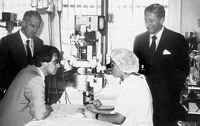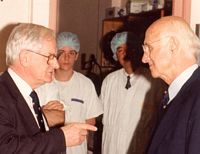


The development of microvascular surgery in Australia
Introduction
Participants
Beginnings
Developing links with academia and hospital medicine
A bevy of supporters
An ever-widening circle of contributors
Building research capacity
Nurturing relationships
Raising funds for research and development
The microsurgeon and the law
Winning community and corporate support
Leadership
The Institute and its style
Endnotes
Index
Search
Help
Contact us

Ann Westmore: Fundraising would appear to be a safety valve that has allowed the Institute to continue to grow and develop when other funding has become less available. I wonder if that has always been the case, and how the fundraising effort has changed over the decades?
Tony Charlton: First, I'd like to say how marvelous it is to be part of this forum. I’ve learnt things that I’ve never known before about the operation of the place despite my years here. I’ve found it a very productive time. Fund-raising is about money and the irony of my involvement in fund-raising is that I’ve never had any. (laughter)
But because I was taken under the wing of people like Sir Laurence, who's been a loyal and great supporter over many years, I learnt some of the ways of doing it. Here, we embarked on many plans to do just that. We went through the gamut of designing letter heads, to getting letters out that don’t bring you much joy, to running events, to doing videos etcetera etcetera to promote the excellence of this Institute.

Tony Charlton (L) and Laurie Muir (R) watch on as Sue McKay explains aspects of microsurgery to visiting Federal MP, Simon Crean in 1987. Used with the permission of the Bernard O’Brien Institute of Microsurgery.
I picked up the phone one day in the late '70s and it was Lindsay Fox.[77].
“Hi Tone,”
“Oh, Lindsay.”
“What are you doing?”
“Just about to go to lunch.”
“Come into town.” He had Bernie at the Athenaeum Club.[78] So we sat down there and Lindsay pronounced what I ought to be doing to help the Microsurgery Foundation. Bernie went into overdrive with that infectious enthusiasm that we all identify and so that's how I became associated with it.
Lindsay, I remember, ran this big dinner at what was then the Regent [Hotel] and is now the Sofitel.[79] True to Lindsay's style, this was quite some event. The most notable thing about it, other than the good camaraderie, was that Lindsay had a Mercedes Benz that I think cost $100,000, and that somebody bought for $300,000, such was Lindsay’s persuasion. That was the style of events, several of which we ran. One of the big nights was a dinner at the Hilton Hotel because Bernie had out here Joseph E. Murray, Nobel prize-winner in plastic and reconstructive surgery.[80] That was a big night and we invited quite a few famous Australians - athletes and academics. Bernie was tickled pink about it all. One of the great joys for me was that there was a band playing and, as Bernie walked in with the guest of honour, everyone stood and cheered. He really enjoyed that. It was a great night. But there have been lots of things to commend this place over many years, so that’s why it shall always be close to my heart. The constant pressure seems unjust when such excellent work occurs here. But many would be trumpeting the same concern - needing to get money to keep these places going. You’d like to have a money machine to print it out.

Bernard O’Brien and Nobel prize-winning surgeon, Joseph Murray, in discussion. Melbourne, 1991. Used with the permission of the Bernard O’Brien Institute of Microsurgery.
Laurie Muir: Tony and I were doing the same thing as we were doing for Bernard at the Alfred, in my case the Baker, and at the Anti-Cancer Council [of Victoria] where we both served. And Bernie used to get very short, 'Don't you give them any of your time. You’re mine.’ (laughter)
 |
Witness to the History of Australian Medicine |  |
© The University of Melbourne 2005-16
Published by eScholarship Research Centre, using the Web Academic Resource Publisher
http://witness.esrc.unimelb.edu.au/060.html